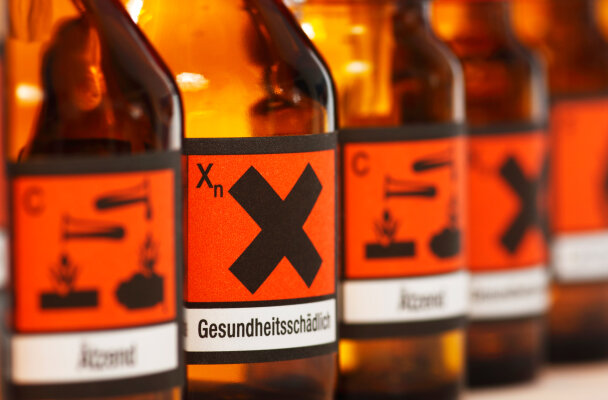Hazard symbols Meaning
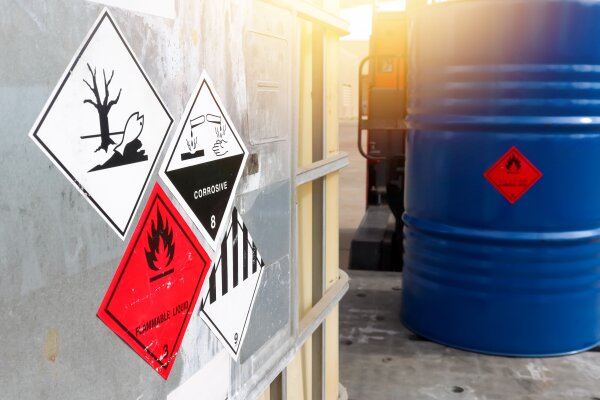
Substances, articles and mixtures with potentially hazardous properties must be labeled accordingly according to current legislation. This is the responsibility of the GHS, which provides the classification and labeling obligation with hazard symbols. We have summarized the meaning of the hazard symbols and hazard pictograms, the criteria used to distinguish between them, and the status of supplementary signal words, H and P phrases.
What are hazardous substances?
When hazardous substances are mentioned, they are substances and mixtures with a harmful effect on humans and/or the environment. They are subject to several laws and regulations, the most important of which are the
- Ordinance on Hazardous Substances (GefStoffV)
- and the CLP Regulation (EC) No. 1272/2008 belong.
The latter forms the basis for the Globally Harmonized System of Classification and Labeling of Chemicals (GHS), which includes the so-called GHS symbols.
The hazard pictograms, R-phrases and H-phrases contained therein are authoritative for the labeling of hazardous substances in Germany and the European Union. They serve the purpose of standardization, so that the meaning of the hazard symbol is recognized at first glance. Different categories are prescribed for different hazards. Since 01 June 2015, these are white fields with a red border; previously, orange fields were common. The transition period ended on 01 June 2017.
Unlike dangerous goods, hazardous materials are not in transit. Therefore, every hazardous material is a hazardous substance, but not every hazardous substance is a dangerous good. This makes further labeling necessary that goes beyond the pictograms according to GHS and expands the meaning of the dangerous goods symbols to include instructions for action in traffic.
Hazard symbols: Meaning and purpose
The symbols for hazardous substances are given as so-called “GHS pictograms”, i.e. as small pictures without text. According to GHS, a total of nine hazardous substance symbols can be distinguished, which in turn are differentiated into three categories:
- Threats to health,
- Dangers for the environment and
- Dangers of a physical nature
This serves the purpose of making the hazardous substance symbol meaning quicker and easier to see. At the same time, the classification aligns the hazard symbols and their meaning more closely with target groups (think consumers, first responders, or transportation personnel).
Hazard symbols: Meaning in case of health hazard
Four GHS pictograms fall into the category of hazard symbols for health hazards. These GHS health hazard symbols include, for example, the hazardous materials pictogram “toxic” because there is an effect on the human organism. The corresponding hazardous substance labels are noted in the following table:
| GHS Pictogram | Hazards | Intake | H phrase |
|---|---|---|---|
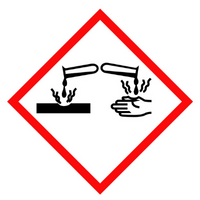 |
Corrosive or irritant effect on skin or severe eye irritation | Contact | Causes severe skin burns and eye damage. |
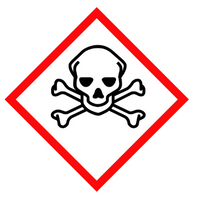 |
Acute toxicity | Oral, dermal and inhalation | Causes severe eye damage; Danger to life if swallowed, in contact with skin and if inhaled; Toxic if swallowed, in contact with skin and if inhaled. |
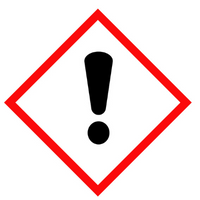 |
Acute toxicity, skin corrosion/irritation, severe eye irritation/damage, skin sensitization, specific target organ toxicity | Oral, dermal and inhalation | Harmful by ingestion, skin contact and inhalation; causes skin irritation and severe skin irritation; may cause allergic skin reactions and respiratory irritation; may cause drowsiness and dizziness. |
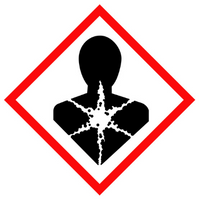 |
Respiratory sensitization; germ cell mutagenicity; carcinogenicity; reproductive toxicity; specific target organ toxicity from single or repeated exposure; aspiration hazard | Oral, dermal or inhalation. | May cause allergy, asthma-like symptoms, or breathing difficulties if inhaled; may (probably) cause genetic defects; may (probably) cause cancer; may (probably) impair fertility or harm the unborn child; may harm infants through breast milk; damages organs; may damage organs (with prolonged or repeated exposure); may be fatal if swallowed and enters airway |
Hazard symbols: Meaning in case of fire and explosion hazard
Among the best known GHS symbols is probably the pictogram “flame”, but it is not the only representative in this category. Other hazard symbols are added:
| GHS pictogram | Danger | H phrase |
|---|---|---|
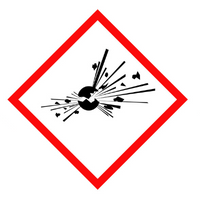 |
Explosive substances or mixtures and articles containing explosives | Instable, explosive; danger of mass explosion (in case of fire); great danger from splinters, explosive and throwing pieces; danger from fire, air pressure and splinters, explosive and throwing pieces; heating can cause explosion and/or fire |
 |
Flammable gases, aerosols, liquids and/or solids; self-reactive substances and mixtures; pyrophoric liquids and/or solids; substances and mixtures capable of self-heating; substances and mixtures which, in contact with water, emit flammable gases; organic peroxides | Extremely flammable gas; flammable gas and/or aerosol; liquid and vapor (slightly/extremely) flammable; flammable solid; heating may cause fire and/or explosion; self-ignites in contact with air; self-heating (in large quantities); may catch fire; contact with water produces flammable gases (which may ignite spontaneously). |
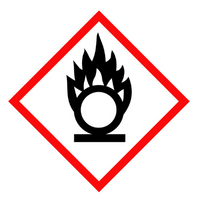 |
Oxidizing gases, liquids and/or solids | Oxidizing agent; may cause and/or intensify fire or explosion. |
Hazard symbols meanings: physical, chemical and environmental hazard
In addition, there are three GHS symbols with meaning for physical and chemical hazards and for the environment. These hazardous substance symbols look like this:
| GHS pictogram | Danger | H phrase |
|---|---|---|
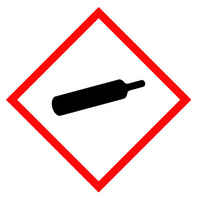 |
Gases under pressure; compressed, liquefied, dissolved and/or cryogenic liquefied gas | Contains gas under pressure; may explode if heated; contains cryogenic gas; may cause cold burn or injury |
 |
Corrosive; corrosive to metals | Corrosive; may be corrosive to metals |
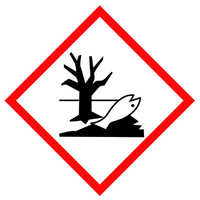 |
Acutely hazardous to the aquatic environment; chronically hazardous to the aquatic environment; harmful to the ozone layer | (Very) toxic to aquatic organisms (long-term effects); harmful to aquatic organisms (long-term effects); harmful to the ozone layer |
Signal word
When transporting hazardous goods, other information in addition to the GHS symbols must be noted on the packaging and on the transport vehicle. This helps to be able to take the right measures in the event of damage and to enable conclusions to be drawn about the hazard category. A distinction is made between the signal words “Caution” and “Danger”:
Caution
If “Caution” is added to the pictogram, the hazard symbol meaning of the GHS is extended by an indication of a medium hazard level. Such attention hazardous substances can be assigned to the following hazard classes and categories:
- Acute toxicity (partial)
- Germ cell mutagenicity (partial)
- Carcinogenicity (partial)
- Reproductive toxicity (partial)
- specific target organ toxicity (terilwise)
- Gases under pressure
- Corrosive to metals
- acutely and/or chronically hazardous to water
- damaging the ozone layer
- explosive (partial)
- flammable gases, aerosols, liquids and/or solids (partial)
- self-reactive substances and mixtures (partly)
- self-heating substances and mixtures (partially)
- Substances and mixtures which, in contact with water, emit flammable gases (partly)
- organic peroxides, liquids and/or solids (partially)
Dangerous
In addition to the signal word for the “Caution” pictogram, there is also the signal word “Dangerous”. It adds the meaning of a serious hazard category to the GHS label. This high hazard level may relate to the following hazard classes and categories:
- etching and irritant effect on the skin
- severe eye damage/irritation
- Sensitization of the respiratory tract
- Acute toxicity (partial)
- Germ cell mutagenicity (partial)
- Carcinogenicity (partial)
- Reproductive toxicity (partial)
- Specific target organ toxicity (partial)
- Aspiration hazard
- explosive (partial)
- instabil explosiv
- self-reactive substances and mixtures
- organic peroxides
- brennbare Gase, Aerosole, Flüssigkeiten und/oder Feststoffe (teilweise)
- self-reactive substances and mixtures (partly)
- self-heating substances and mixtures (partially)
- Substances and mixtures which, in contact with water, emit flammable gases (partly)
- pyrophoric liquids and/or solids
- organic peroxides, liquids and/or solids (partially)
H-phrases
H-phrases and P-phrases can also be assigned to the individual GHS symbols. In the EU, EUH phrases are also used. They give concise safety instructions for hazardous substances and have an analogous use as, for example, the R- and S-phrases; which can be found in the EU labeling. The “H” in H-phrases stands for “Hazard Statements” and is used for hazards arising from chemical substances and their manufacture:
- H200 series: Physical hazards
- H300 series: Health hazards
- H400 series: Environmental hazards
The modular system consists of a hazard warning and three numbers. The first number indicates a grouping (physical hazard, health hazard or environmental hazard) and is followed by two consecutive numbers. Each H-phrase can be assigned to a specific hazard, which are provided with special safety instructions.
P phrases
The P-phrases work according to the same principle, where “P” stands for “Precautionary Statemens” and refers to safety instructions when handling the respective hazardous substances:
- P100 series: General
- P200 series: Prevention
- P300 series: Reaction
- P400 series: Storage
- P500 series: Disposal
Hazardous substances and their symbols in the household
Not only in everyday industrial life, but also at home, we encounter hazard labels every day–think, for example, of cleaning agents and utensils such as insect spray or wood polish. In particular, older and longer-lasting products that have been in the household for several years may have the outdated GHS hazard symbols from before 2015.
New are the pictograms “Health hazard” and “Exclamation mark”, which not only look different, but also carry additional hazard warnings. In the following hazardous substance labeling table you will find the comparison of the old and new symbols:
| Old symbol | Current symbols | Danger | Household example |
|---|---|---|---|
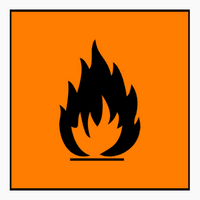 |
 |
highly flammable | Spiritus |
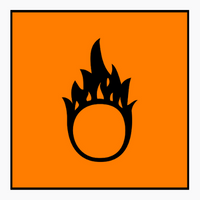 |
 |
fire-promoting | Cleaner with active oxygen |
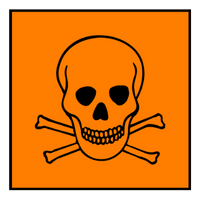 |
 |
Toxic and/or life-threatening | Organic solvents |
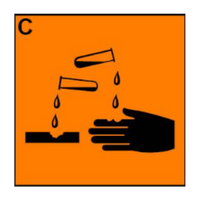 |
 |
corrosive | Mold Remover |
 |
 |
Explosion hazard | Fireworks |
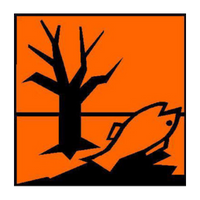 |
 |
environmentally hazardous | Paints and dyes |
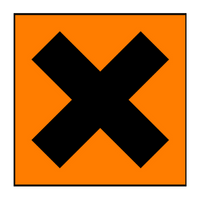 |
 |
harmful and hazardous to health | Petrol |
| no obsolete sign availabled |  |
Gas under pressure | Gas cylinders |
Hazard symbols: Their meaning should be known
Not only in the operational environment, but also in everyday life, we constantly encounter hazardous substances with corresponding symbols on the packaging. In order to protect yourself from the harmful effects of hazardous substances, you should be familiar with the applicable hazard symbols and their meaning – this will help you to take appropriate precautions when handling the substances.
FAQ
Since June 01, 2015, the nine GHS hazard symbols have described the hazards “explosive”, “flammable”, “oxidizing”, “corrosive”, “toxic”, “harmful and irritant”, “hazardous to health”, “hazardous to the environment” and “gases under pressure”.
Hazard signs can be differentiated into several symbols and icons that together provide a comprehensive hazard assessmentfor a substance. These include GHS pictograms, signal words, identification letters, H-phrases and P-phrases, as well as hazard classes and hazard categories.
The REACH regulation defines nine hazard symbols according to the GHS system. These are white boxes with a red border, in which a suitable symbol for the type of hazard is shown. In the past, the hazard symbols were shown in orange fields, which can sometimes still be seen on old packaging.
Hazard symbols are ubiquitous in everyday life and can be found on various packaging of substances. These include, for example, cleaning agents, nail polish remover, spray cans or gas bottles. In addition, there are common representatives such as fuels, coatings and paints, and essential oils.
The GHS pictogram with a black exclamation mark indicates the signal word “Caution” and warns against harmful and irritating substances. These can, for example, causerespiratory and skin irritation or have acute toxicity. Narcotic effects are also possible.
Do you have questions about the topic or would you like to suggest a topic? Please contact us by phone at +49 30 2096579 00 or send us an email at info@medsolut.com.

